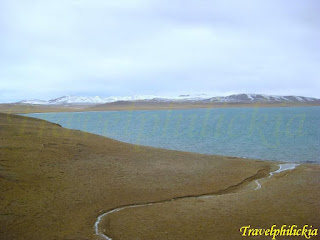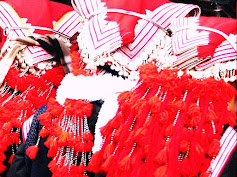Gotten Qinghai-Tibet railway train (青藏铁路) ticket of Train No. K917 from our Xining tour guide (left photo below). From Xining West Railway Station (right photo below) we continued our journey to Lhasa using train.

 Boarded the modern and contemporary looking train (left photo below). Besides departing from Xining, there is another route which departs from Lanzhou (right photo below).
Boarded the modern and contemporary looking train (left photo below). Besides departing from Xining, there is another route which departs from Lanzhou (right photo below).

 The total route is 1,956 km long which stretches from Xining in the province of Qinghai via Golmud to Lhasa in Tibet (photo below). This is the highest railway in the world, which rising up to more than 5,000-meters above sea level. The railway is not at high speed; its top speeds are only 160 km/h on the section form Xining to Golmud but slow down to only 100 km/h from Golmud to Lhasa.
The total route is 1,956 km long which stretches from Xining in the province of Qinghai via Golmud to Lhasa in Tibet (photo below). This is the highest railway in the world, which rising up to more than 5,000-meters above sea level. The railway is not at high speed; its top speeds are only 160 km/h on the section form Xining to Golmud but slow down to only 100 km/h from Golmud to Lhasa.
Train Cars
There are three classes on the train, namely Soft Sleeper with 4 beds per cabin (left photo below), Hard Sleeper with 6 beds per cabin (right photo below) and Hard Seat (bottom left photo). Trains usually comprise 16 cars, with a dining car (bottom right photo) located between the soft sleepers and the rest of the train.



 We opted the soft sleeper which cost RMB 770 per person (included in the tour package).
We opted the soft sleeper which cost RMB 770 per person (included in the tour package).Soft Sleeper
- For soft sleeper there is additional LED screen for each bed (left photo below) with a separate controller mounted onto the wall (right photo below). However I did not attempt to turn on the screen.

 Also there is oxygen nozzle outlet available to each soft sleeper above the bed (left photo below) and nasal catheter is provided upon request (right photo below). Fortunately, none of us needed to use this feature.
Also there is oxygen nozzle outlet available to each soft sleeper above the bed (left photo below) and nasal catheter is provided upon request (right photo below). Fortunately, none of us needed to use this feature.




There are no showers in the train, but there are rows of sinks for washing up (photos below).

 Unlimited hot water is available onboard (left photo below). Although there are carts running up and down the aisles selling mildly overpriced snacks, drinks and fresh fruit, we did what most locals would do and brought some instant noodles and milk teas (right photo below). These were bought from a local supermarket in Xining.
Unlimited hot water is available onboard (left photo below). Although there are carts running up and down the aisles selling mildly overpriced snacks, drinks and fresh fruit, we did what most locals would do and brought some instant noodles and milk teas (right photo below). These were bought from a local supermarket in Xining.

Foldable seats are located outside the Soft and Hard Sleeper cabins along the aisles and are often fully occupied (photos below).

 Oxygen nozzles are also located along the train aisles and most passengers would be using them after the Tanggula station (photos below).
Oxygen nozzles are also located along the train aisles and most passengers would be using them after the Tanggula station (photos below).

Railway Construction
Qinghai-Tibet railway is definitely a masterpiece of engineering. The most challenging task was how to built a railway over a Permafrost which is a perennially soft and wet soil in summer, and hard and stretching soil in winter. This had been a problem to engineers over the world but the Chinese engineers successfully figured out ways to resolve.
The best approach to avoid permafrost areas is by building bridges instead railroad (photos below). Although expensive, the bridges will have the least impact on the area.

 Another important solution to permafrost is stone embankments of a layer of loosely piled chunks of granite about the size of baseballs that allow enough space between the rocks for air to circulate freely, thus maintaining the ground to remain frozen (left photo below).
Another important solution to permafrost is stone embankments of a layer of loosely piled chunks of granite about the size of baseballs that allow enough space between the rocks for air to circulate freely, thus maintaining the ground to remain frozen (left photo below).In some places, a special long pipe known as thermosiphon was stuck 5-meters into the ground. Filled with ammonia, these thermosiphons allowed ammonia to evaporate and condensate inside these pipes to facilitate cooling between the ground and surrounding air (right photo below).

 Sceneries along the route
Sceneries along the routeSection from Xining (西宁) to Golmud (格尔木)
- The train departed from Xining West station at 1504 hours, and passed through the industrial and rural areas before reaching the open grassland (left photo below) with occasionally view of mountains at about 6 pm (right photo below).

 Groups of domestic yaks could be seen grazing on the grasslands along the journey (photos below).
Groups of domestic yaks could be seen grazing on the grasslands along the journey (photos below).

 A remote temple (left photo below) and transmission towers (right photo below) from a power station were spotted.
A remote temple (left photo below) and transmission towers (right photo below) from a power station were spotted.

 Heavy industry like coal-fired factory was seen from the train (photos below).
Heavy industry like coal-fired factory was seen from the train (photos below).

 Granite-like mountains dominated the scenery for a short time in the train journey (left photo below) while the mountainous landscapes were common sights (right photo below).
Granite-like mountains dominated the scenery for a short time in the train journey (left photo below) while the mountainous landscapes were common sights (right photo below).

 The sky turned dark after about 8 pm and no photo was taken thereafter. Tried to rest on train at about 11 pm but could only get intermittent sleep due to the "shaky" train ride. I was woken up at about 1.10 am by the glaring lights from the Golmud train station where the train stopped briefly to refill.
The sky turned dark after about 8 pm and no photo was taken thereafter. Tried to rest on train at about 11 pm but could only get intermittent sleep due to the "shaky" train ride. I was woken up at about 1.10 am by the glaring lights from the Golmud train station where the train stopped briefly to refill.
Day Four
Sceneries along the route
Section from Golmud (格尔木) to Tanggula (唐古拉)
- Woke up at about 6.30 am just at the break of dawn. The train seemed to enter into a snow land where most of the mountains and grassland were covered with snow (photos below).



 As the sun rises, the grassland color changed to dark brown (photos below).
As the sun rises, the grassland color changed to dark brown (photos below).

 It took about half an hour before the sun is visible from the far end of the mountains (photos below).
It took about half an hour before the sun is visible from the far end of the mountains (photos below).

 After breakfast, the landscape changed to a pastel of white and brown colors (photos below).
After breakfast, the landscape changed to a pastel of white and brown colors (photos below).




Not too sure if the photo taken was a glacier (left photo below). The train finally passed through the Tanggula (唐古拉) Train Station at about 8.22 am (right photo below). It is the highest train station in the world at 5,072-meters above sea level.


- One of the famous sceneries along the railway is the view of Tsonag Lake (错那湖) between Nagqu Town (那曲镇) and Pagnag Town (帕那镇). It is a major lake in northern Tibet Autonomous Region and considered holy to the Tibetans (photos below).





 The journey continued with more impressive snow-capped mountains along the route (photos below).
The journey continued with more impressive snow-capped mountains along the route (photos below).




The Nyenchen Tanglha Mountains (念青唐古拉山) is another imposing scenery (photo below). It is a 700-km long mountain range with a highest point at 7,090-meters.
Landscape changed again back to rural area where native Tibetan houses (left photo below) and herds of yak (right photo below) could be seen.

 Train stations Dangxiong (当雄) and Yanbajing (羊八井) could be identified from their signages (photos below).
Train stations Dangxiong (当雄) and Yanbajing (羊八井) could be identified from their signages (photos below).

 The train finally entered Lhasa where industrial buildings (left photo below) and Lhasa River (right photo below) could be distinguished.
The train finally entered Lhasa where industrial buildings (left photo below) and Lhasa River (right photo below) could be distinguished.


- Managed to capture some of the sceneries along the journey. For easy reference, I had tagged the scenes according to the three sections of the train journey (video below).
We reached Lhasa at about 3.03 pm. After some introduction by our Tibet tour guide, we then checked in to Jiangsu Shengtaiyuan Hotel. After some rest at the hotel, we were out again for our dinner.
Dinner
We were brought to a restaurant Chongqing Old Duck Soap Health Preserving Hall (重庆老鸭汤养生堂) located in Lhasa city just about 7-mins drive from our hotel (left photo below). This restaurant had simple furnishing with customized tables for hotpots (right photo below).


We were offered with Rhodiola rosea tea (红景天茶) which supposed to prevent high altitude sickness (left photo below). Hot pot was then served as our dinner (right photo below).

 There was no activity after dinner as it was intended for us to recuperate and acclimatize to the high altitude.
There was no activity after dinner as it was intended for us to recuperate and acclimatize to the high altitude.
 Posts RSS
Posts RSS




